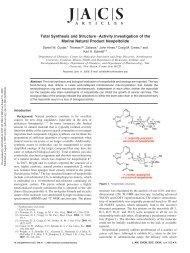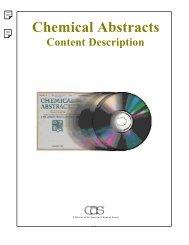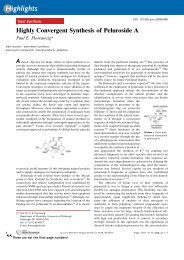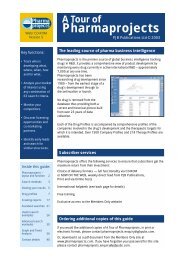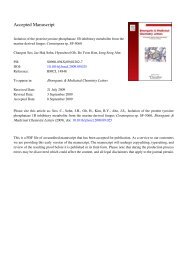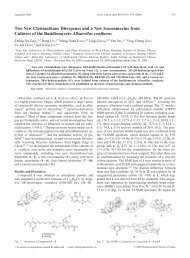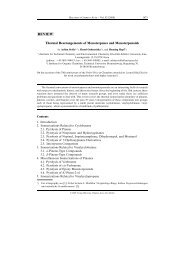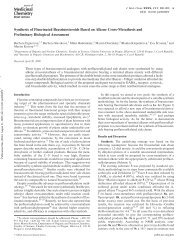Expeditious Synthesis of Vialinin B, an Extremely Potent Inhibitor of ...
Expeditious Synthesis of Vialinin B, an Extremely Potent Inhibitor of ...
Expeditious Synthesis of Vialinin B, an Extremely Potent Inhibitor of ...
You also want an ePaper? Increase the reach of your titles
YUMPU automatically turns print PDFs into web optimized ePapers that Google loves.
Downloaded by SHANGHAI INST OF ORG CHEM on October 22, 2009 | http://pubs.acs.org<br />
Publication Date (Web): October 5, 2009 | doi: 10.1021/ol9020833<br />
<strong>Expeditious</strong> <strong>Synthesis</strong> <strong>of</strong> <strong>Vialinin</strong> B, <strong>an</strong><br />
<strong>Extremely</strong> <strong>Potent</strong> <strong>Inhibitor</strong> <strong>of</strong> TNF-r<br />
Production<br />
Yue Qi Ye, †,‡ Hiroyuki Koshino, † Jun-ichi Onose, ‡ Kunie Yoshikawa, ‡ Naoki Abe, ‡<br />
<strong>an</strong>d Shunya Takahashi* ,†<br />
RIKEN, Wako, Saitama 351-0198, Jap<strong>an</strong>, <strong>an</strong>d Department <strong>of</strong> Nutritional Science,<br />
Faculty <strong>of</strong> Applied Bio-Science, Tokyo UniVersity <strong>of</strong> Agriculture, 1-1-1 Sakuragaoka,<br />
Setagaya-ku, Tokyo 156-8502, Jap<strong>an</strong><br />
shunyat@riken.jp<br />
Received September 9, 2009<br />
ABSTRACT<br />
A first total synthesis <strong>of</strong> vialinin B, a powerful inhibitor (IC50 20 pM) <strong>of</strong> TNF-r production, is described. The key reactions include a double<br />
Suzuki-Miyaura coupling <strong>of</strong> electron-rich aryl bromide with a couple <strong>of</strong> phenylboronic acids, a Cu-mediated Ullm<strong>an</strong>n reaction, <strong>an</strong>d a LHMDSpromoted<br />
phenylacetylation. This synthesis proceeded in 11 steps with 18% overall yield from a known sesamol derivative.<br />
<strong>Vialinin</strong> B (1) is a highly oxygenated dibenz<strong>of</strong>ur<strong>an</strong> bearing<br />
p-hydroxyphenyl <strong>an</strong>d phenylacetoxy groups that was isolated<br />
by us from the dry fruiting bodies <strong>of</strong> <strong>an</strong> edible Chinese<br />
mushroom, Thelephora Vialis, <strong>an</strong>d shows <strong>an</strong> extremly potent<br />
inhibitory activity against tumor necrosis factor (TNF)-R<br />
production in rat basophilic leukemia (RBL-2H3) cells (IC50<br />
) 20 pM vs. 0.25 nM for FK-506). 1 TNF-R is a potent<br />
multifunctional cytokine that mediates a variety <strong>of</strong> biological<br />
actions with a central role in the pathogenesis <strong>of</strong> inflammatory<br />
diseases such as rheumatoid arthritis (RA). 2 Thus,<br />
inhibitors <strong>of</strong> TNF-R production in activated mast cells <strong>an</strong>d<br />
basophils are promising c<strong>an</strong>didates for a new type <strong>of</strong><br />
<strong>an</strong>tiallergic agent. The mode <strong>of</strong> action <strong>of</strong> 1 <strong>an</strong>d its inhibition<br />
mech<strong>an</strong>ism, however, still remain unresolved. Its occurrence<br />
† RIKEN.<br />
‡ Tokyo University <strong>of</strong> Agriculture.<br />
(1) Xie, C.; Koshino, H.; Esumi, Y.; Onose, J.; Yoshikawa, K.; Abe,<br />
N. Bioorg. Med. Chem. Lett. 2006, 16, 5424–5426.<br />
(2) (a) Vassalli, P. Annu. ReV. Immunol. 1992, 10, 411–452. (b) Sieper,<br />
J.; Braun, J. Expert Opin. Emerging Drugs 2002, 2, 235–246. (c) Holgate,<br />
S. T. Cytokine 2004, 28, 152–157.<br />
10.1021/ol9020833 CCC: $40.75 © XXXX Americ<strong>an</strong> Chemical Society<br />
ORGANIC<br />
LETTERS<br />
XXXX<br />
Vol. xx, No. x<br />
in nature was also limited. To clarify the target molecule <strong>of</strong><br />
1 <strong>an</strong>d synthesize new <strong>an</strong>tiallergic drugs, development <strong>of</strong> <strong>an</strong><br />
efficient method for the synthesis <strong>of</strong> 1 is required. Although<br />
m<strong>an</strong>y oligoarenes including p-terphenyls have been synthesized<br />
so far, 3 no paper has appeared dealing with the<br />
synthesis <strong>of</strong> highly oxygenated dibenz<strong>of</strong>ur<strong>an</strong>s. 4 Described<br />
herein is the first total synthesis <strong>of</strong> vialinin B (1), thus<br />
providing a general method for the synthesis <strong>of</strong> this family.<br />
In the synthetic study <strong>of</strong> this unique molecule, construction<br />
<strong>of</strong> the dibenz<strong>of</strong>ur<strong>an</strong> skeleton <strong>an</strong>d selective protection <strong>of</strong><br />
(3) For recent review, see: (a) St<strong>an</strong>forth, S. P. Tetrahedron 1998, 54,<br />
263–303. (b) Bellina, F.; Carpita, A.; Rossi, R. <strong>Synthesis</strong> 2004, 2419–2440.<br />
(c) Doucet, H. Eur. J. Org. Chem. 2008, 201, 2013–2030. (d) M<strong>an</strong>abe, K.;<br />
Ishikawa, S. Chem. Commun. 2008, 382, 3829–3838, <strong>an</strong>d references cited<br />
therein.<br />
(4) For recent syntheses <strong>of</strong> simple benz<strong>of</strong>ur<strong>an</strong> derivatives without<br />
polyoxy functions, see: (a) W<strong>an</strong>g, C.; Piel, I.; Glorius, F. J. Am. Chem.<br />
Soc. 2009, 131, 4194–4195. (b) Hussain, M.; Hung, N. T.; L<strong>an</strong>ger, P.<br />
Tetrahedron Lett. 2009, 50, 3929–3932. (c) Yamashita, M.; Hir<strong>an</strong>o, K.;<br />
Satoh, T.; Miura, M. Org. Lett. 2009, 11, 2337–2340. (d) Komine, Y.;<br />
Kamisawa, A.; T<strong>an</strong>aka, K. Org. Lett. 2009, 11, 2361–2364. (e) Kawaguchi,<br />
K.; Nak<strong>an</strong>o, K.; Nozaki, K. Org. Lett. 2008, 10, 1199–1202.
Downloaded by SHANGHAI INST OF ORG CHEM on October 22, 2009 | http://pubs.acs.org<br />
Publication Date (Web): October 5, 2009 | doi: 10.1021/ol9020833<br />
hydroxyl groups in the central core are the main problems<br />
throughout the synthetic course. To resolve such problems,<br />
we designed a synthetic strategy as shown in Scheme 1.<br />
Scheme 1<br />
Removal <strong>of</strong> two phenylacetyl groups in the target molecule<br />
leads to the O-protected dibenz<strong>of</strong>ur<strong>an</strong> catechol 2. Cleavage<br />
<strong>of</strong> the internal ether linkage c<strong>an</strong> revert 2 back to the<br />
desymmetrical p-terphenyl 3. This would be synthesized by<br />
Suzuki-Miyaura coupling 5 <strong>of</strong> bromide 4 with a couple <strong>of</strong><br />
boronic acids 5 <strong>an</strong>d 6. 6 The methylene acetal moiety in 4<br />
was expected to resist m<strong>an</strong>y reagents until the later stage <strong>of</strong><br />
total synthesis, <strong>an</strong>d the formyl group was introduced for a<br />
regioselective coupling as well as for <strong>an</strong> equivalent <strong>of</strong> a<br />
masked hydroxyl group. These retrosynthetic <strong>an</strong>alyses allowed<br />
us to select sesamol (7) as the starting material.<br />
<strong>Synthesis</strong> beg<strong>an</strong> with preparation <strong>of</strong> the central core 4<br />
(Scheme 2). According to De Kimpe’s procedure, 7 sesamol<br />
(7) was tr<strong>an</strong>sformed into 8 in 2 steps. The hydroxyl group<br />
in 8 was protected as methoxymethyl (MOM) ether to give<br />
4. This compound seems to be a potential precursor <strong>an</strong>d a<br />
versatile starting material for the synthesis <strong>of</strong> p-terphenyls<br />
bearing a variety <strong>of</strong> substituents on the central ring as well<br />
as 1 provided that a regioselective Suzuki-Miyaura coupling<br />
<strong>of</strong> 4 with different types <strong>of</strong> boronic acids is possible. The<br />
(5) Miyaura, N.; Suzuki, A. Chem. ReV. 1995, 95, 2457–2483.<br />
(6) Boronic acid 6 was prepared from 4-chlorocatechol via 1,2bis(benzyloxy)-4-bromo-5-chlorobenzene<br />
(22) in 3 steps: (1) Br2, acetic acid,<br />
rt; (2) BnBr, K2CO3, n-Bu4NI, acetone, 60 °C (86% in 2 steps); (3) n-BuLi,<br />
(i-PrO)3B, THF, -78 to 0 °C (97%); see the Supporting Information.<br />
(7) Maes, D.; Vervisch, S.; Debenedetti, S.; Davio, C.; M<strong>an</strong>gelinckx,<br />
S.; Giubellina, N.; De Kimpe, N. Tetrahedron 2005, 61, 2505–2511.<br />
Scheme 2<br />
first successful example was demonstrated by the coupling<br />
<strong>of</strong> 4 with 5 <strong>an</strong>d 6 as follows. We initially examined a<br />
coupling with a simple boronic acid 5, <strong>an</strong>d found that reaction<br />
with Pd(PPh3)4 in the presence <strong>of</strong> cesium carbonate afforded<br />
a coupling product 9 in 84% yield. 8 The position <strong>of</strong> the newly<br />
introduced phenyl group was determined by the 1 H NMR<br />
<strong>an</strong>alyses including HMBC <strong>an</strong>d NOE experiments (Scheme<br />
2). 9 Second coupling was achieved by the action <strong>of</strong> Pd(OAc)2<br />
in the presence <strong>of</strong> the lignad 13, 10 giving desymmetrical<br />
p-terphenyl 11 in 84% yield. Encouraged by the above<br />
results, we next ch<strong>an</strong>ged the order <strong>of</strong> the coupling partner.<br />
Reaction <strong>of</strong> 4 <strong>an</strong>d 6 under the same conditions (Pd(PPh3)4cesium<br />
carbonate) gave 10 in moderate yield (∼54%)<br />
whereas a combination <strong>of</strong> Pd(OAc)2 <strong>an</strong>d 13 or 2-di-tertbutylphosphino-2′,4′,6′-triisopropylbiphenyl<br />
resulted in no<br />
reaction or a complex mixture. The best results were obtained<br />
by the use <strong>of</strong> Pd(OAc)2 <strong>an</strong>d triphenylphosphine instead <strong>of</strong><br />
the sterically hindered lig<strong>an</strong>ds to give 10 in 78% yield. 8 The<br />
ring connectivity was also confirmed by the 1 H NMR<br />
<strong>an</strong>alysis. As <strong>an</strong>ticipated, the second coupling did not proceed<br />
by using a system <strong>of</strong> Pd(OAc)2-triphenylphosphinepotassium<br />
phosphate. But <strong>an</strong> exch<strong>an</strong>ge <strong>of</strong> the phophine from<br />
triphenyl phosphine to 13 dramatically improved the reaction,<br />
providing 12 in 91% yield. This compound was also obtained<br />
through a one-pot Suzuki-Miyaura coupling. Thus, after<br />
completion <strong>of</strong> the first coupling between 4 <strong>an</strong>d 6 (TLC<br />
<strong>an</strong>alyses), 5, 13, <strong>an</strong>d Pd(OAc)2 (0.05 equiv) were added in<br />
(8) Although several spots were observed on TLC, a double coupling<br />
product could not be isolated.<br />
(9) In the 1 H NMR spectra <strong>of</strong> 9 <strong>an</strong>d 10, the up-field shift <strong>of</strong> the formyl<br />
proton due to the shielding effect <strong>of</strong> the neighboring aromatic ring was<br />
observed.<br />
(10) Barder, T. E.; Walker, S. D.; Martinelli, J. R.; Buchwald, S. L.<br />
J. Am. Chem. Soc. 2005, 127, 4685–4696.<br />
B Org. Lett., Vol. xx, No. x, XXXX
Downloaded by SHANGHAI INST OF ORG CHEM on October 22, 2009 | http://pubs.acs.org<br />
Publication Date (Web): October 5, 2009 | doi: 10.1021/ol9020833<br />
the same flask, <strong>an</strong>d the reaction was continued for a further<br />
3 h. St<strong>an</strong>dard workup followed by chromatography on silica<br />
gel gave a 67% yield <strong>of</strong> 12.<br />
In constructing the p-terphenyl skeleton, we next turned<br />
our attention to the benz<strong>of</strong>ur<strong>an</strong> formation. Prior to the<br />
reaction, the MOM group in 11 was hydrolyzed, giving 14<br />
as <strong>an</strong> unstable solid (Scheme 3). The intramolecular Oarylation<br />
<strong>of</strong> 14 was investigated under several conditions<br />
including Pd(OAc)2 or Pd2(dba)3 in the presence <strong>of</strong> 13 or<br />
2-di-tert-butylphosphino-2′,4′,6′-triisopropylbiphenyl or 2-(ditert-butylphosphino)biphenyl,<br />
10,11 or Cu catalyst such as<br />
N<strong>an</strong>o-CuO 12 <strong>an</strong>d Cu2O. 13 All attempts, however, were<br />
unsuccessful, <strong>an</strong>d a desired benz<strong>of</strong>ur<strong>an</strong> could not be isolated.<br />
On the other h<strong>an</strong>d, Bayer-Villiger oxidation 14,15 <strong>of</strong> 12<br />
provided the corresponding formate 15, which, upon treatment<br />
with base, afforded <strong>an</strong> unstable phenol 16. The<br />
cyclization from 16 to 17 was a troublesome step again. Pdcatalyzed<br />
etherification <strong>of</strong> 16 did not proceed while the Cumediated<br />
cyclization reaction gave 17 (∼54%) along with<br />
<strong>an</strong> o-quinone without the MOM group (∼25%). These results<br />
reflected the instability <strong>of</strong> 16 toward the reaction conditions<br />
employed. After extensive experimentation, it was found that<br />
treatment <strong>of</strong> the formate 15 with a Cu catalyst directly<br />
produced 17. The use <strong>of</strong> Cu2O-pyridine was quite effective;<br />
<strong>an</strong> 88% yield <strong>of</strong> 17 was attained. Removal <strong>of</strong> the methyleneacetal<br />
moiety was performed by lead tetraacetate (LTA)<br />
oxidation, 16 which was previously employed in the total<br />
synthesis <strong>of</strong> natural p-terphenyls. 17 Contrary to our expecta-<br />
(11) Burgos, C. H.; Barder, T. E.; Hu<strong>an</strong>g, X.; Buchwald, S. L. Angew.<br />
Chem., Int. Ed. 2006, 45, 4321–4326.<br />
(12) (a) Kidwai, M.; Mishra, N. K.; B<strong>an</strong>sal, V.; Kumar, A.; Mozumdar,<br />
S. Tetrahedron Lett. 2007, 48, 8883–8887. (b) Zh<strong>an</strong>g, J.; Zh<strong>an</strong>g, Z.; W<strong>an</strong>g,<br />
Y.; Zheng, X.; W<strong>an</strong>g, Z. Eur. J. Org. Chem. 2008, 511, 5112–5116. (c)<br />
Schareina, T.; Zapf, A.; Cotté, A.; Müller, N.; Beller, M. Tetrahedron Lett.<br />
2008, 49, 1851–1855, <strong>an</strong>d references cited therein.<br />
(13) Wipf, P.; Jung, J.-K. J. Org. Chem. 2000, 65, 6319–6337.<br />
(14) Camps, F.; Coll, J.; Messeguer, A.; Pericás,M.A.Tetrahedron<br />
Lett. 1981, 22, 3895–3896.<br />
(15) No presence <strong>of</strong> potassium fluoride decreased the yield <strong>of</strong> 15.<br />
Scheme 3<br />
tion, the major product was de-MOM product not a desired<br />
orthoester when 17 was treated with LTA in benzene. 18 We<br />
found that the oxidation was sensitive to the O-protecting<br />
group at the C-6 position <strong>of</strong> 17. For example, the use <strong>of</strong><br />
ether-type protecting groups such as MOM, Bn, <strong>an</strong>d TBDMS<br />
resulted in a complex mixture or no reaction while introduction<br />
<strong>of</strong> electron-withdrawing groups like acetate into 6-OH<br />
<strong>of</strong> 18 gave good results. Consequently, the MOM group in<br />
17 was exch<strong>an</strong>ged to a benzyloxycarbonyl group. LTA<br />
oxidation <strong>of</strong> 19 thus obtained proceeded nicely, giving the<br />
corresponding monoacetate 20 in good yield. Exposure <strong>of</strong><br />
this to mild acidic conditions led to removal <strong>of</strong> the acetal<br />
group, providing <strong>an</strong> unstable catechol 2 (R ) OZ), which<br />
was immediately submitted to phenylacetylation. Deprotonation<br />
from two hydroxyl groups in 2 was accomplished by<br />
the action <strong>of</strong> lithium bis(trimethylsilylamide) (LHMDS) in<br />
THF at -78 °C, 19 <strong>an</strong>d the resulting lithium salt reacted with<br />
phenylacetyl chloride to provide 21 in good yield. Finally,<br />
all benzyl groups in 21 were removed by hydrogenolysis<br />
with Pd(OH)2 to give vialinin B (1). The spectral data <strong>of</strong> 1<br />
were identical with those <strong>of</strong> the natural product. 20<br />
We have developed a short <strong>an</strong>d efficient method for the<br />
synthesis <strong>of</strong> vialinin B (1) in 13 steps from a commercially<br />
available sesamol (7). The key features <strong>of</strong> this synthesis are<br />
as follows: (1) synthesis <strong>of</strong> a highly functionalized pterphenyl<br />
skeleton based on a Suzuki-Miyaura coupling;<br />
(2) construction <strong>of</strong> a benz<strong>of</strong>ur<strong>an</strong> skeleton by a Cu-mediated<br />
(16) Ikeya, Y.; Taguchi, H.; Yoshioka, I. Chem. Pharm. Bull. 1981, 29,<br />
2893–2898.<br />
(17) (a) Ye, Y.-Q.; Koshino, H.; Onose, J.; Yoshikawa, K.; Abe, N.;<br />
Takahashi, S. Org. Lett. 2007, 9, 4131–4134. (b) Ye, Y.-Q.; Koshino, H.;<br />
Onose, J.; Negishi, C.; Yoshikawa, K.; Abe, N.; Takahashi, S. J. Org. Chem.<br />
2009, 74, 4642–4645.<br />
(18) LTA oxidation <strong>of</strong> 5,6-bis(methoxymethoxy)benzo[d][1,3]dioxole<br />
as a model compound gave the corresponding orthoester in high yield.<br />
(19) Esterification <strong>of</strong> 2 in the presence <strong>of</strong> DMAP in pyridine or<br />
triethylamine gave a mixture <strong>of</strong> 21 <strong>an</strong>d its mono-phenylacetate.<br />
(20) The original 13 C NMR data (δ 119.83 for C-9b) <strong>of</strong> 1 denoted in<br />
ref 1 was a typographical errror <strong>an</strong>d should be revised to 119.38 ppm.<br />
Org. Lett., Vol. xx, No. x, XXXX C
Downloaded by SHANGHAI INST OF ORG CHEM on October 22, 2009 | http://pubs.acs.org<br />
Publication Date (Web): October 5, 2009 | doi: 10.1021/ol9020833<br />
intramolecular Ullm<strong>an</strong>n reaction; <strong>an</strong>d (3) LHMDS-promoted<br />
phenylacetylation. This method would be quite useful for<br />
the preparation <strong>of</strong> new <strong>an</strong>tiallergic drugs 21 as well as for<br />
bioprobes to clarify the target molecule.<br />
Acknowledgment. This work was supported by the<br />
Chemical Genomics Project (RIKEN) <strong>an</strong>d in part by a<br />
(21) For recent <strong>an</strong>ti-RA drugs, see: (a) Brenn<strong>an</strong>, F. M.; Ch<strong>an</strong>try, D.;<br />
Jackson, A.; Maini, R.; Feldm<strong>an</strong>n, M. L<strong>an</strong>cet 1989, 334, 244–247. (b) Maini,<br />
R.; St. Clair, E. W.; Breedveld, F.; Furst, D.; Kalden, J.; Weism<strong>an</strong>, M.;<br />
Solen, J.; Emery, P.; Harrim<strong>an</strong>, G.; Feldm<strong>an</strong>n, M.; Lipsky, P. L<strong>an</strong>cet 1999,<br />
354, 1932–1939.<br />
Gr<strong>an</strong>t-in-Aid for Scientific Research from the Ministry <strong>of</strong><br />
Education, Science, Sports, <strong>an</strong>d Culture <strong>of</strong> Jap<strong>an</strong>. We are<br />
grateful to Dr. Y. Hongo (RIKEN) for mass spectral<br />
measurements, <strong>an</strong>d Ms. K. Yamada in RIKEN for the<br />
elemental <strong>an</strong>alyses.<br />
Supporting Information Available: Experimental procedures<br />
<strong>an</strong>d NMR spectra <strong>of</strong> 1, 4, 9-12, <strong>an</strong>d 14-21. This<br />
material is available free <strong>of</strong> charge via the Internet at<br />
http://pubs.acs.org.<br />
OL9020833<br />
D Org. Lett., Vol. xx, No. x, XXXX



